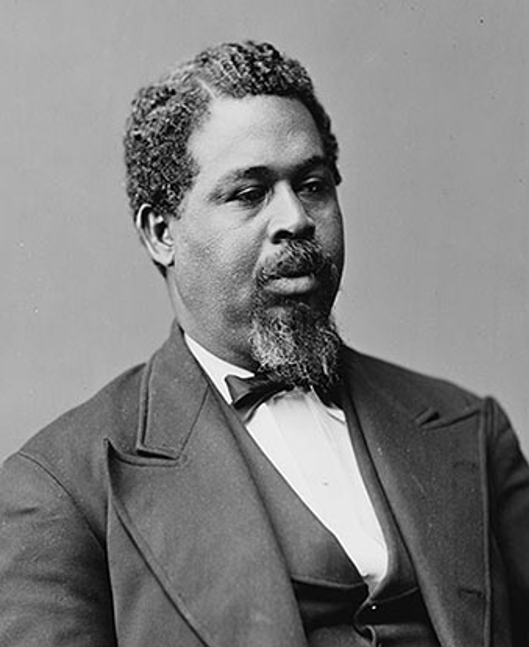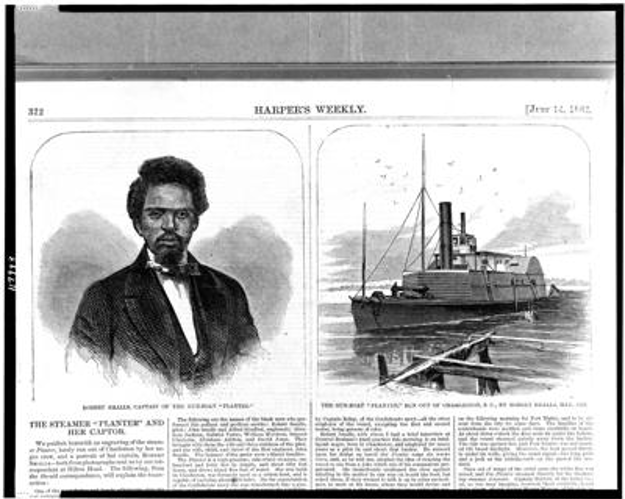Early Life
Robert Smalls was born on April 5, 1839 in Beaufort, South Carolina. He was enslaved by John McKee and worked as a house servant until the age of 12. After that, McKee leased Robert out to work as a waiter and sailor. When Smalls was 18, he worked out an agreement with McKee to keep some of his earnings. In time, he used his savings to purchase his wife and daughter from their owner for $800. Saving money to purchase family members was not uncommon at the time. It was done to keep families together and possibly give them the chance to be emancipated.
An Opportunity
Robert was sent to work on the steamship Planter in 1861 at 22 years old. The Planter was owned by John Ferguson, who leased it out to the Confederate military. The ship was used as a supply transport and a personal dispatch for General Roswell Ripley, the commander of the 2nd Military District of South Carolina. When the Union Navy set up a blockade 10 miles outside of Charleston, it gave Robert an idea. Robert had always thought about escaping with his wife and children, but never had an opportunity until then. During his time on the Planter, he devised an extraordinary plan to not only gain his own freedom, but freedom for 15 others as well. His plan was to commandeer the Planter, pick up his family and additional freedom seekers, and pilot it out to the Union blockade.
Even though Robert was already a skilled sailor, he studied as much as he could about operating the Planter. From commands, to routes, to signals, to engineering, he knew the key to his success was deception through knowledge. He even studied the body movements of General Ripley and Captain Charles Relyea to deceive the confederate soldiers on land. He believed if he could make the ship look like it was on a normal mission, he may have a chance. Smalls devised his plan with the other enslaved crew members on the Planter.
Escape
On the night of May 12, 1862, Captain Relyea ordered Smalls and the other enslaved crew members to guard the Planter while the Confederate sailors went home to stay with their families. This was actually a violation of General Orders, No. 5. That night, Smalls and the others disguised themselves as crew members. Smalls disguised himself as Captain Relyea, even wearing his straw hat. They sailed the ship up the Cooper River to pick up Smalls’ family and the other freedom seekers. Once everyone was on board, they turned around and headed down the Cooper River toward the Union blockade. This was the most dangerous part of the escape. Smalls had to pilot the ship through a gauntlet of forts and artillery stations. Any simple mistake could have aroused the suspicion of the Confederate soldiers manning their stations. The forts and artillery stations could have easily destroyed the Planter, killing everyone on board.
Some of Smalls’ crew wanted to try and sneak past the forts, but Smalls knew that the noise from the engine and the smoke coming out of the stacks made that impossible. Smalls knew they had to maintain their composure, stay the course, and make everything seem normal. The forts (Castle Pinckney, Fort Ripley, Fort Johnson and Fort Sumter) were also checkpoints for ships moving in and out of Charleston harbor. The ships and the checkpoints would signal each other as a means of communication. One by one, Smalls signaled the checkpoints and they signaled back. Before the Confederates knew what was going on, Smalls had successfully piloted the Planter out to the Union blockade.
When the Union sailors boarded the Planter, they were dismayed with the situation: 16 African Americans aboard a Confederate supply ship at a Union blockade. When Smalls met the Union sailors, he saluted them and said, “I am delivering this war material including these cannons and I think Uncle Abraham Lincoln can put them to good use.”
When word spread throughout the North about this incredible act, Smalls became the most famous African American in the country and a hero for the cause. The Confederacy offered a $2,000 reward for his capture. Smalls had humiliated the Confederacy, and challenged their belief of African American inferiority. How could an illiterate, enslaved man commandeer a Confederate ship, pilot it past all those checkpoints, and hand it over to the Union blockade? After gaining his freedom, he served the Union as the first African American Captain of a military vessel, the Planter and the Keokuk.




